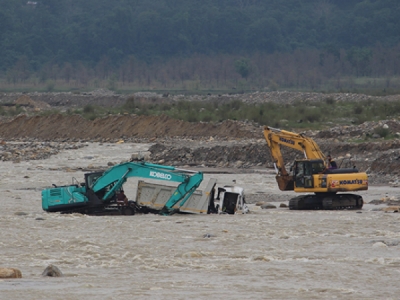
Posted on May 27, 2019
Boulder business in Gelephu has come to a grinding halt after the implementation of the carrying capacity rule earlier this week.
However, the extraction of the riverbed materials (RBM) continues as dredging along the riverbeds in Sarpang and Gelephu are in full swing.
Thousands of metric tonnes (MT) of RBM are deposited daily at the stockyards in Gelephu. There are at least two million MT of boulders stocked along the Moa Khola worth billions of Ngultrum.
Natural Resources Development Corporation Ltd (NRDCL) has hired close to 70 excavators to carry out dredging and mitigation work at Moa Khola.
The fate of RBM
NRDCL’s manager in Gelephu, Choney Dorji, said that a new working modality was adopted which allowed NRDCL to carry out the dredging work departmentally.
The department has hired machines and operators from 17 private contractors. The contractors dredge, extract, sieve, load, transport the materials to the stockyards, reload the RBM, and hand them over to NRDCL.
Choney Dorji said that the contractors could not sell RBM directly. They have to purchase it from the NRDCL once they deposit it to their stockyards.
The payments for the hiring of machines are released based on the disposal of the materials. This means that contractors would be paid only when export of RBM takes place, which currently is on hold.
“We have been releasing the payments on a monthly basis to the contractors. But now since we are not able to sell the materials, we might not be able to pay them for their machines,” said the manager.
On May 22, around 4pm, a flashflood washed away the newly constructed embankments along the Mao Khola and left men and machines stranded on the other side of the river.
Choney Dorji said that with monsoon setting in, flood could wash away all the deposited RBM. This means the contractors might not receive payments for the collected materials.
He said that the main objective of the project was to channelise Mao Khola and to prevent water from entering the private and state properties. “We were making good progress.”
NRDCL will dredge about 8km of riverbed in Mao Khola that would be about 2m deep and around 50m wide.
Time running out
Despite continuous dredging work, the danger of flashfloods is ever present. It was learnt that restriction on exporting the RBM has affected the progress of work at site.
“While we understand that the priority should be to make Mao Khola safe, there is little we could do when we are not paid to meet our daily expenses,” said one of contractors. “We are paid only when we manage to sell the materials to Bangladesh. This has stopped since a month now.”
The environmental clearance to execute the dredging works at Mao Khola expires on July 26. Officials said that all machines would be pulled back after July 26.
A February 27 circular from the Cabinet states that the government has decided to review laws on surface collection, including dredging to harmonise them. “In this regard, the Ministry of Agriculture and Forests is directed to suspend issuance of new and renewal of approval for surface collection including dredging activities with immediate effect.”
The circular also states that stocked materials from surface collection and dredging activities should be entirely disposed by August 31.
The contractors hired by NRDCL are worried they might not be able to recover the cost incurred in the dredging work. “Even if we clear all the RBM and channelise the river, our payment would still remain uncertain if the export is not reopened,” said a contractor.
Proprietor of Khamzang Export, Dotila, said that they had not been breaching the carrying capacity rule. He claimed that all the 10-wheeler trucks were carrying 16m3 (cubic metre) of load as per the carrying capacity of the vehicle.
“We pay for 16m3 to NRDCL and we should be allowed to ferry the load,” he said. “16m3 is the specified carrying capacity for a 10-wheeler as per the manufacture’s book.”
There are two different carrying capacities in different units specified for a truck. While the capacity of the vehicle’s bed is specified in volume (16m3), the registration certificate (blue book) reflects the capacity in mass (15 metric tonne). On conversion, 16m3 of boulder is about 25MT. The conversion values are different for different materials.
“This has been the accepted practice until recently and we are all suffering because of the sudden change in the rule,” said Dotila. “This issue would not only kill the boulder business but all businesses in its entireness will fall if immediate action is not taken.”
He added that some of the exporters had started selling land to repay the loans on their vehicles.
Tshering Transport’s owner, Sonam Dorji, said that recently about 50 vehicles ferrying cement to the hydro projects in Wangdue and Trongsa were imposed fines as they were overloaded.
“If this continues, I don’t think we could continue delivering cement to the hydro projects,” he said, adding that he supplies cement to both Punatshangchu I and II, Mangdechhu, and Nikachhu projects. “There are already concerns over the delay of these projects and if we cannot supply the materials on time, it would be more costly for the government.”
Source: kuenselonline.com





